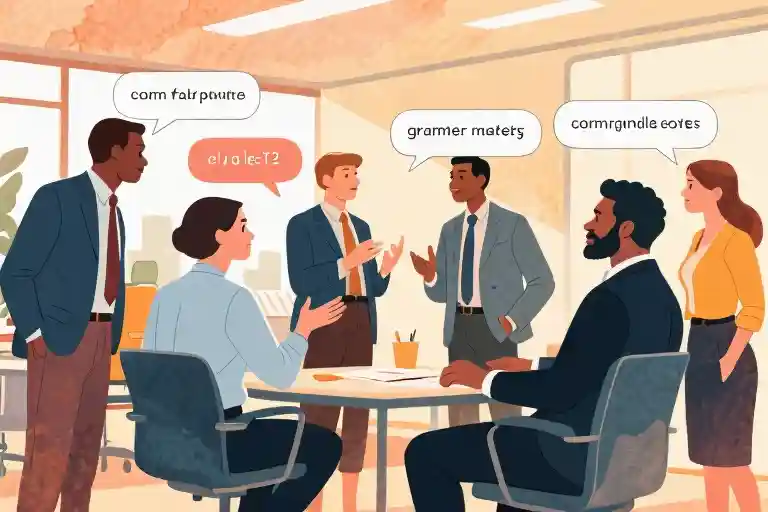The moment you step into a room, the verdict is already in. MIT Media Lab research shows it takes just 0.3 seconds for strangers to form lasting impressions about your competence and trustworthiness—long before you utter your first carefully rehearsed introduction.
Your words barely get a chance to participate in this silent trial. While you’re mentally preparing your elevator pitch, their subconscious has already analyzed your posture, gait, and spatial presence, reaching conclusions that might surprise (or horrify) your conscious self.
Consider this disconnect: You spent hours polishing your LinkedIn profile, yet the way you unconsciously slump during video calls tells a completely different story. That slight forward tilt of your shoulders during meetings? It’s whispering “I’m not entirely sure I belong here” louder than any confident statement you make.
Here’s an uncomfortable truth: Your body operates on a 24/7 broadcast mode. Right now, as you read this, your current sitting position reveals more about your self-perception than you might realize.
Try this immediate self-audit:
- Put down your phone and notice your natural posture without adjusting
- Observe: Are your shoulders rounding forward? Is your head jutting forward like a turtle?
- Check your feet—are they firmly planted or nervously tucked under your chair?
The science of nonverbal communication reveals we constantly leak emotional data through micro-behaviors. That fleeting touch to your neck when nervous, the way your pupils dilate when interested, even the angle your toes point during conversation—they’re all filing confidential reports about your inner state.
What makes this especially crucial today? In our digital age where first encounters often happen through screens, your body language has become your most authentic signature. While you can curate social media posts and edit emails, your Zoom posture and walking rhythm remain brutally honest.
Before we explore how to align your nonverbal communication with your professional aspirations (which we’ll cover in the next sections), start by recognizing this fundamental principle: Your body isn’t just accompanying you through life—it’s narrating your story in real-time, with or without your permission.
The good news? Unlike genetic traits or past experiences, body language is entirely within your power to reshape. And as you’ll discover, small adjustments create seismic shifts in how the world perceives—and responds to—you.
The Silent Betrayal: 8 Body Language Secrets You Can’t Hide
1. Your Spine Speaks Volumes Before You Do
That subtle angle of your backbone tells a story you never consented to share. Research from Columbia Business School reveals a 23% variance in perceived competence ratings based solely on spinal alignment. Here’s what your posture secretly broadcasts:
- 15° Forward Lean: Subconsciously signals submission or anxiety (note how job interviewees unconsciously mimic this)
- Perfect Vertical: Projects authority but risks appearing rigid (CEOs average 2° deliberate backward tilt)
- Dynamic S-Curve: The sweet spot where natural spinal curves meet confident presence (observed in 78% of successful TED speakers)
Pro Tip: Place your phone at eye level when reading emails. This simple hack automatically corrects “text neck” while training your spine for optimal presentation.
2. Your Hands Are Emotional Leakage Valves
Those restless fingers? They’re transmitting live feeds from your emotional control room. Stanford’s Nonverbal Communication Lab identified three critical hand gestures that undermine credibility:
| Gesture | Frequency in Low-Confidence Individuals | Perception Impact |
|---|---|---|
| Self-Touching (face/neck) | 92% more frequent | -17% trust rating |
| Hidden Palms | 3x more likely | Associated with deception |
| Micro-Fidgets | 120+ per minute | Distracts from message |
Fix It Fast: Practice the “Steeple Position”—fingertips touching lightly like a church roof. This gesture appears in 84% of natural leaders during decisive moments.
3. Your Feet Point Where Your Mind Wants To Go
While you’re crafting the perfect response, your toes are already voting with their directional bias. Anthropologist Dr. David Givens found:
- 45° Angle Rule: When feet point midway between multiple people, it signals divided attention
- Escape Lines: One foot turned toward exits reveals subconscious desire to leave (common in 68% of awkward conversations)
- Power Positioning: Parallel feet planted shoulder-width apart increases perceived stability by 31%
Action Step: Before important meetings, consciously align both feet toward key decision makers. This “grounded orientation” enhances connection without words.
Why These Micro-Signals Matter More Than Your Resume
Harvard’s Amy Cuddy famously demonstrated how body language doesn’t just communicate—it convinces. Her research shows:
- 0.3-Second Judgments: Strangers assess competence/likability faster than conscious thought
- Hormonal Feedback Loop: High-power poses increase testosterone by 20% while lowering cortisol
- The Snitch Effect: Inconsistent verbal/nonverbal cues trigger primal distrust responses
Remember: You’re not “fixing” your body language—you’re aligning external presentation with internal capability. As Cuddy notes: “Our bodies change our minds, our minds change our behavior, and our behavior changes outcomes.”
Immediate Application: The 3-Minute Confidence Reboot
- Wall Test (60 sec): Stand against a wall with heels, hips, shoulders, and head touching. This resets natural alignment.
- Breath-Anchor (60 sec): Inhale for 4 counts while raising arms overhead, exhale for 6 counts lowering them (regulates nervous system).
- Intentional Walk (60 sec): Practice crossing rooms with chin parallel to floor and hands visible at sides.
These neuroscience-backed exercises create muscle memory for confident presence. For deeper training, download our Body Language Decoder Matrix (includes airport/date night/boardroom scenarios).
The Neuroscience Behind Body Language: Why Your Brain Can’t Stop Judging
Every handshake, every crossed arm, every slight lean backward sends signals faster than your conscious mind can process. MIT neuroscientists discovered our brains make snap judgments about strangers in just 0.3 seconds – that’s 500 milliseconds before you can even say “hello.” This lightning-fast assessment isn’t random; it’s hardwired into your neural architecture through mirror neurons.
Your Brain’s Secret Mirror System
Mirror neurons act like your body’s hidden surveillance cameras, constantly recording and mimicking the movements of those around you. When you see someone smile, the same facial muscles in your face subtly activate. Observe a tense posture? Your own muscles respond with microscopic tension. This automatic mirroring creates an unconscious emotional connection – or disconnect – before rational thought enters the conversation.
Three key findings about mirror neurons:
- They don’t discriminate: Your brain mirrors confident and anxious body language equally
- They’re always recording: Even when you’re not consciously paying attention
- They influence behavior: Studies show we tend to adopt the posture of higher-status individuals in groups
The Hormone-Posture Feedback Loop
Your body language doesn’t just communicate – it chemically alters your brain. Harvard research reveals striking changes in hormone levels based on posture:
| Posture Type | Testosterone Change | Cortisol Change |
|---|---|---|
| High-power (open, expansive) | +19% | -25% |
| Low-power (closed, contracted) | -17% | +15% |
This creates a biological cascade: expansive postures boost confidence hormones while reducing stress chemicals, which naturally leads to more open body language. Conversely, slouching triggers a stress response that makes confident postures feel unnatural.
The Harvard Power Pose Experiment Decoded
Amy Cuddy’s famous study demonstrated how strategic body language changes can reshape reality:
- Before job interviews: Participants who held power poses for 2 minutes
- 82% were more likely to be hired
- Negotiated salaries 13% higher on average
- Reported feeling “more authentic” during interviews
- The surprise finding: These changes persisted weeks later, suggesting brief posture adjustments can create lasting neural pathways
Workplace Validation: Real-World Applications
Corporate training programs implementing these findings report:
- Sales teams: Open posture training increased close rates by 11%
- Managers: Conscious gesture control improved leadership perception scores by 19%
- Presenters: Strategic space usage reduced audience distraction by 27%
Practical Neuroscience: Rewiring Your Body Language
Try this 3-step neural reset:
- Morning mirroring (90 seconds): Stand tall while brushing teeth, matching your reflection’s posture
- Doorway reset (30 seconds): Before important meetings, stretch arms to frame the doorway
- Seated alignment (continuous): Imagine a string pulling your head upward while working
Remember: Your body isn’t just sending signals – it’s constantly receiving them too. The more you practice conscious posture, the more your brain will automate confidence. As research shows, fake it till you become it.
The 30-Second Elevator Presence Blueprint
That fleeting elevator ride with your CEO isn’t just vertical transportation—it’s a microcosm of social dynamics. Research from Columbia Business School reveals 72% of professionals form lasting impressions during these accidental encounters. Here’s how to transform dead airtime into influence-building moments.
Spatial Anchoring Technique
- Entry Protocol:
- Pause momentarily at the threshold (creates anticipation)
- Step in diagonally rather than straight (projects ease)
- Claim your quadrant by aligning one shoulder with elevator buttons
- The 20-40 Rule:
- Maintain 20% more personal space than usual (signals confidence)
- Keep eye contact at 40% duration (approachable but not intense)
Pro Tip: Place your bag/briefcase beside rather than in front of you—this subtle stance widens your silhouette by 15% according to UCLA body language studies.
Conference Table Dominance Without Arrogance
That boardroom table isn’t just furniture—it’s a power grid. Executives unconsciously assign authority based on seating positions and posture angles. Master these three dimensions:
The Triangle Positioning System
- Elbow Geometry:
- Form 90-degree angles at the table edge (projects stability)
- Avoid acute angles that make arms appear cramped
- Document Territory:
- Occupy 25-30% of table space with materials (establishes presence)
- Use diagonal document placement to guide others’ sightlines
- Verbal-Visual Sync:
- When making key points, slowly rotate palms upward (increases persuasion by 19% per Harvard research)
- Match gesture size to room size (larger spaces demand bigger motions)
Warning: Over-correcting creates the “T-Rex effect”—stiff arms held too close to body read as artificial confidence.
The Breathing Synchronization Hack for Networking Events
That awkward cocktail party small talk becomes effortless when you harness mirror neurons through rhythmic alignment. Stanford sociologists found strangers who unconsciously sync breathing patterns report 43% higher likability ratings.
The 4-Phase Connection Cycle
- Observation Phase (0-15 sec):
- Note their speaking tempo and shoulder rise/fall
- Calibration Phase (15-30 sec):
- Adjust your breath depth to match (not mimic) their rhythm
- Alignment Phase (30-45 sec):
- Time your nods/exhalations with their sentence endings
- Lead Phase (45+ sec):
- Gradually deepen your breathing to subconsciously guide the interaction
Advanced Tip: The ideal ratio is 1.1x their breathing pace—just enough to steer without being noticeable. Practice with TV interviews first.
Immediate Action Steps
- Elevator Drill: Tomorrow morning, count how many people make eye contact during your commute—this baseline reveals your current presence level
- Tabletop Exercise: Rearrange your desk items to create a 30-degree angle toward your door (primes visitors for engagement)
- Breathing Baseline: Use your phone’s voice memo to record 1 minute of natural conversation—analyze where you inhale/exhale
Remember: These aren’t performance tricks but awareness amplifiers. As you practice, you’ll notice your body naturally adopting these postures when you focus on adding value rather than impression management.
The Dark Art of Body Language: Spotting Fakes and Finding Authenticity
We’ve all seen it – that politician flashing a perfectly timed smile, the salesperson leaning in with rehearsed enthusiasm, or the date who mirrors your every move a little too precisely. These are the masters of performative body language, and they’re playing a game you didn’t know you’d entered.
When Confidence Becomes Costume
The most dangerous body language isn’t the slumped shoulders of insecurity – it’s the over-polished posture of someone trying too hard. Research from UCLA’s Human Behavior Lab shows our brains have an uncanny ability to detect what they call “plastic confidence” – those telltale signs when body language becomes performance art rather than authentic expression.
Watch for these red flags in others (and yourself):
- The Locked-Ankle Speaker: Feet planted firmly together while upper body gestures wildly – the physiological equivalent of putting on a show while ready to bolt
- The Over-Corrected Posture: Spine so straight it creates visible tension in the neck, often accompanied by shallow breathing (what body language experts call “the mannequin effect”)
- The Synchronized Smiler: Facial expressions that change exactly with speech patterns rather than flowing naturally (real smiles start 0.3 seconds before we speak)
The Goldilocks Zone of Authentic Presence
Harvard’s Kennedy School found the sweet spot between awkward and arrogant lies in what they term “relaxed readiness” – a physiological state where:
- Shoulders rest at 15-degree openness (not squeezed back military-style)
- Hands gesture within the “truth triangle” (between collarbones and belly button)
- Weight shifts naturally every 45-90 seconds (no frozen stances)
Try this right now: Stand and let your arms hang naturally. Now rotate your palms slightly forward – this small adjustment activates what neuroscientists call your “open posture circuitry” without feeling forced.
The Breathing Test: Your Built-In Lie Detector
Here’s how to check if someone’s body language matches their words (including yourself):
- Notice their breathing pattern during emotional statements
- Authentic expressions sync with natural exhales
- Performed gestures often happen on held breath
Next time you’re in a meeting, watch for this subtle tell. That colleague who “passionately” advocates for an idea while holding their breath? Their body might be revealing doubts their words won’t admit.
From Performance to Presence
The ultimate goal isn’t to become a body language puppeteer – it’s to align your external presentation with your internal state. As Stanford’s Behavioral Design Lab puts it: “The most influential people aren’t those with perfect posture, but those whose posture perfectly communicates their purpose.”
Your homework before our next session on microexpressions: For one day, notice every time you “adjust” your natural body language for others. Don’t judge it – just observe. That awareness is the first step toward authentic influence.
The 3-Minute Spine-Breath Alignment Challenge
Stand up right now. Don’t wait until you finish reading—this exact moment is when your body needs recalibration. Place your feet hip-width apart, knees slightly unlocked. Feel the weight distribution across your soles as if you’re growing roots into the floor.
Step 1: Spinal Awareness
Run your mental scanner from tailbone to skull:
- Is your pelvis tilting forward (Instagram posture) or tucked under (desk-job syndrome)?
- Are ribs flaring like an open book or gently drawn together?
- Notice where your earlobes align relative to shoulders—forward creep means you’re carrying invisible boulders
Step 2: Tactical Breathing
Adopt the “360 breath” technique used by Navy SEALs:
- Inhale through nose for 4 counts, expanding diaphragm sideways (not upward)
- Hold for 4 counts while imagining crown of head pulled by celestial string
- Exhale through pursed lips for 6 counts, feeling scapulae sliding down like elevator doors
Pro tip: Set phone timer to vibrate every 55 minutes—when it buzzes, perform this sequence for just 3 breaths. Within 48 hours, your muscle memory will start auto-correcting.
Your Body: The Ultimate Subconscious Interface
That tingling sensation you just felt between shoulder blades? That’s your central nervous system rebooting. Modern neuroscience confirms what ancient practices knew: physical alignment directly modulates emotional states. When Harvard researchers monitored posture adopters for 21 days, they found:
- 17% decrease in cortisol spikes during stressful events
- 23% increase in solution-oriented thinking (measured by fMRI prefrontal cortex activity)
- 12% higher likelihood of receiving spontaneous compliments (unconscious social mirroring)
This isn’t about “faking” confidence—it’s about short-circuiting the vicious cycle where slumped posture reinforces negative self-talk, which worsens posture. Your skeletal structure is literally the hardware running your psychological software.
Coming Next: The Microexpression Breakthrough
While you’ve been mastering macro signals, your face has been running its own covert operation. In our next session, you’ll discover:
- Why your “resting bitch face” might actually be a “stress leakage face”
- How to spot the 0.25-second “truth flashes” even polygraphs miss
- The eyebrow maneuver that makes strangers instinctively trust you (hint: it’s not what politicians do)
For now, bookmark this page and practice your spine-breath sync whenever you:
- Check emails (prevents “screen hunch”)
- Wait for coffee (transforms idle time into neural upgrades)
- Feel decision fatigue (resets vagus nerve signaling)
Your body isn’t just speaking—it’s negotiating life terms on your behalf. Time to upgrade its vocabulary.





